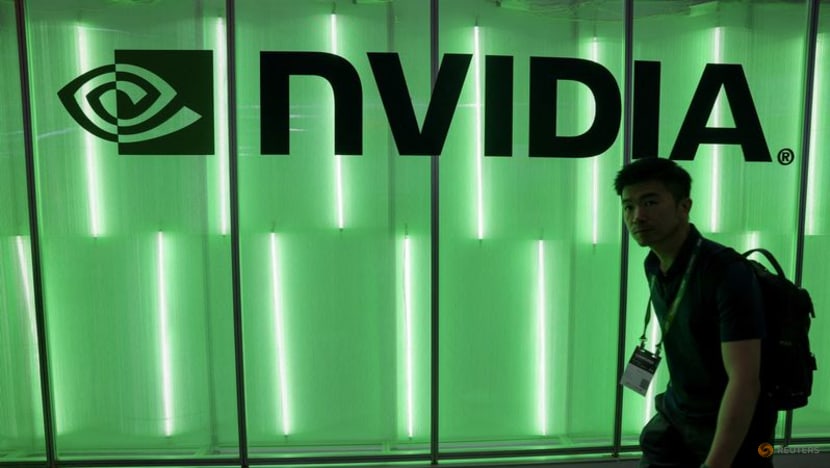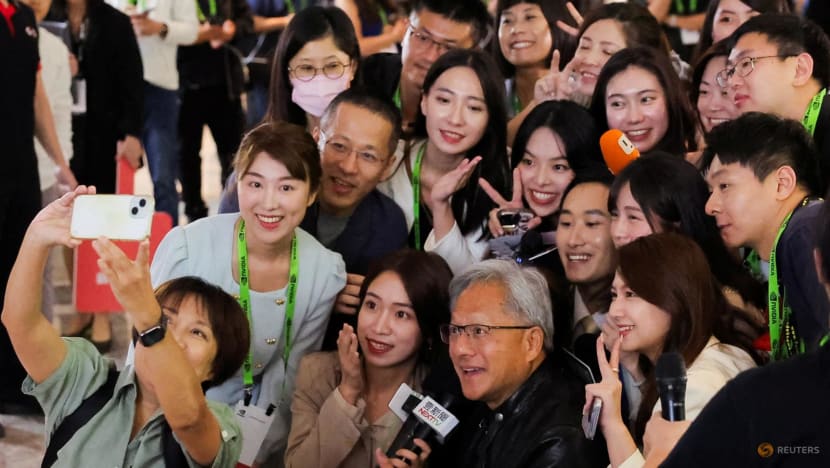CNA Explains: The story of Nvidia's rise to become the world's No 1 company
From its humble beginnings in an American diner, to CEO Jensen Huang attaining rock star status, CNA takes a look at the journey - and the growing hype - behind Nvidia.

A person walks past an Nvidia logo in Taipei, Taiwan on June 5, 2024. (Photo: Reuters/Ann Wang)

This audio is generated by an AI tool.
SINGAPORE: In March, artificial intelligence chip giant Nvidia’s market capitalisation exceeded US$2 trillion.
Reports said the company took just 180 days to double its value from US$1 trillion - less than half the time it took tech behemoths like Apple and Microsoft.
Over 60 days later, Nvidia’s value climbed above US$3 trillion.
And on Jun 18, it became the world’s most valuable company.
Soon, however, a days-long sell-off took hold, and it ceded the No 1 position to Microsoft.
Still, it's been a heady, blistering ride for Nvidia.
What's Nvidia's story?
It began in a humble American diner.
The year was 1993 and three friends - Jensen Huang, Chris Malachowsky and Curtis Priem – met in a Denny’s in Silicon Valley to discuss a business idea.
They wanted to create a chip that would enable realistic, three-dimensional graphics on personal computers.
The company’s first product was a flop – it wasn’t what the market wanted or needed, and Nvidia almost went out of business, according to previous reports.
Nvidia’s second chip, meanwhile, was “doomed” from the start, even while it was being developed for video game firm Sega.
Other 3D graphics companies had emerged, and the rest of the world, including Microsoft, was using software that would not support Nvidia’s product.
Sega’s then-CEO Shoichiro Irimajiri made an unusual decision to release Nvidia from its obligations, but continue paying them as agreed in the contract.
“It was all the money that we had. And it gave us just enough money to hunker down,” Mr Huang, Nvidia's CEO, has said.
For many years, he would go on to kick off presentations to staff by reciting Nvidia's unofficial motto: “Our company is thirty days from going out of business”.
It did see other bumps in the road, such as receiving subpoenas over possible anti-trust violations and becoming the subject of a class action lawsuit.
But Nvidia went public in 1999, entered the S&P 500 stock index in 2001, and is far from going bust now.
What's Nvidia's secret sauce?
Its “massive advantage” over other chip companies lies in how it specialised in designing graphics processing units (GPUs) for thirty years, Moody’s senior vice president Raj Joshi once told NBC News.
In contrast, rival companies such as Intel and Advanced Micro Devices were focused on producing central processing units (CPUs).
GPUs use parallel processing, where many calculations can be carried out at the same time, making them more efficient than CPUs - and far more useful for newfangled things like cryptocurrency mining and AI.
For instance, a GPU can divide up the mathematical problem in crypto mining and assign it to various parts of the chip, solving it more quickly than if a traditional computing method was used, according to American media outlet Vox.
GPUs also power generative AI: When a prompt is entered into something like the ChatGPT assistant, the AI model has to generate an answer from massive datasets. To do so, it needs thousands of GPUs performing parallel processing at data centres.
Nvidia saw an opportunity to reimagine its GPU for AI, and created a programming model that has become the industry standard.
Reports have also pointed to the company's competitive edge in networking.
GPUs need to be connected to boost their processing power, and Nvidia acquired in 2019 a company supplying networking technology. This optimises the performance of Nvidia’s network of chips, and its competitors have not been able to do the same, according to an Economist analysis.
Today, with AI creeping into popular tech platforms – from Netflix to social media apps – Nvidia’s chips are becoming more and more central to the man on the street and to everyday life. In tandem, the firm now holds its own among names that consumers have been more familiar with.
Related:
Who's the face of Nvidia?
Mr Huang, the CEO, has very much taken centrestage.
It's not just that he fronts the company’s chip launches, which have been likened to Apple events.
As Meta CEO Mark Zuckerberg quipped, Mr Huang is the Taylor Swift of the tech world, filling out stadiums for his conferences as though they were concerts.
In Taiwan, where he was born, “Jensanity” intensifies, with Mr Huang treated like a rock star, posing for pictures and signing autographs - including on a woman's chest - everywhere he goes.
Mr Huang - in his signature leather jacket - regularly visits Taiwan and has said Nvidia will continue to invest in the island, including potentially building a regional headquarters there, the BBC reported.

Related:
Why does Nvidia matter to Singapore and the region?
Last year, Singapore contributed US$2.7 billion or around 15 per cent to Nvidia’s revenue for the third quarter.
The company said the figure referred to the billing to customers headquartered in Singapore, but might not reflect actual shipments.
Still, demand for GPUs from here is large and growing, fuelled by cloud service providers, Mr Huang told reporters in December.
Mr Alex Capri, a senior lecturer at the National University of Singapore’s business school, said Singapore must maintain strong business ties with Nvidia if it wants to distinguish itself as an innovation hub.
“Nvidia is at the centre of a new AI-driven economy,” Mr Capri told CNA.
“Access to Nvidia’s chips will determine winners and losers in a geopolitical competition to build and maintain data centres and cloud infrastructure; and excel in everything from cleantech (to) e-commerce and fintech."
For Singapore - and Malaysia - to become “prime hotbeds” for chip production, the countries need to use AI-driven processes, and will need Nvidia.
What's next for Nvidia?
The chip giant’s customers are now trying to become competitors, mainly because they can’t afford to keep paying so much for Nvidia's products, Gil Luria, a senior analyst at the financial firm D.A. Davidson Companies, told Vox.
He said Microsoft used to spend less than 10 per cent of their capital expenditure on Nvidia. That figure is now 40 per cent.
Nvidia’s chips are far more expensive than comparable ones from AMD, and it’s unclear if the company will be able to keep coming up with even better products. The pace at which microchip technology can advance seems to be slowing, according to reports.
Nvidia's dominance has also attracted scrutiny from regulators around the world.
Where the company goes from here, and whether it continues to soar, also largely depends on the fate of its catalyst in the first place - AI.
If or when the world moves on to AI inferencing – where trained AI models are used to solve a task – high-performance chips might not be needed as much.
Meanwhile, traffic to ChatGPT has fallen, and some observers believe AI enthusiasm will ebb.
As with all new tech coming into the public consciousness, there will always be a wave of hype, D.A. Davidson’s Mr Luria told Vox. “Then at some point, the hype gets too big, and then you get past it and get into the trough of disillusionment.”
He expects to see that with AI.
Tech titans are also likely to diversify away from Nvidia in the long run, according to analysts like Brian Colello from the Morningstar financial services consultancy.
But it still doesn’t mean Nvidia will fade into oblivion. “Most likely, these efforts will chip away at, but not supplant, Nvidia’s AI dominance,” said Collelo.















